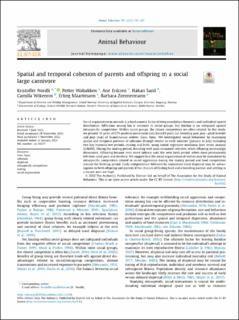Spatial and temporal cohesion of parents and offspring in a social large carnivore
Nordli, Kristoffer; Wabakken, Petter; Eriksen, Ane; Sand, Håkan; Wikenros, Camilla; Maartmann, Erling; Zimmermann, Barbara
Peer reviewed, Journal article
Published version
Permanent lenke
https://hdl.handle.net/11250/3092613Utgivelsesdato
2023Metadata
Vis full innførselSamlinger
Sammendrag
Social organization in animals is a fundamental factor driving population dynamics and individual spatial distribution. Affiliation among kin is common in social groups, but kinship is no safeguard against intraspecific competition. Within social groups, the closest competitors are often related. In this study, we present 14 years of GPS-position movement data from 65 pairs (i.e. breeding pair, pup–adult breeder and pup–pup) of Scandinavian wolves, Canis lupus. We investigated social behaviour by examining spatial and temporal patterns of cohesion through winter to early summer (January to July) including two key reproductive periods, mating and birth, using mixed regressive nonlinear time series analysis (GAMM). During the mating period, breeding wolf pairs remained cohesive, while offspring increasingly dissociated. Offspring became even more solitary until the next birth period, when most permanently left their natal pack and territory. We suggest that the social organization of wolves may be modulated by intraspecific competition related to social aggression during the mating period and food competition around the birthing period. Early independence followed by immediate natal dispersal may be advantageous to both offspring and parents if the chances of finding food and a breeding partner and settling in a vacant area are high.

